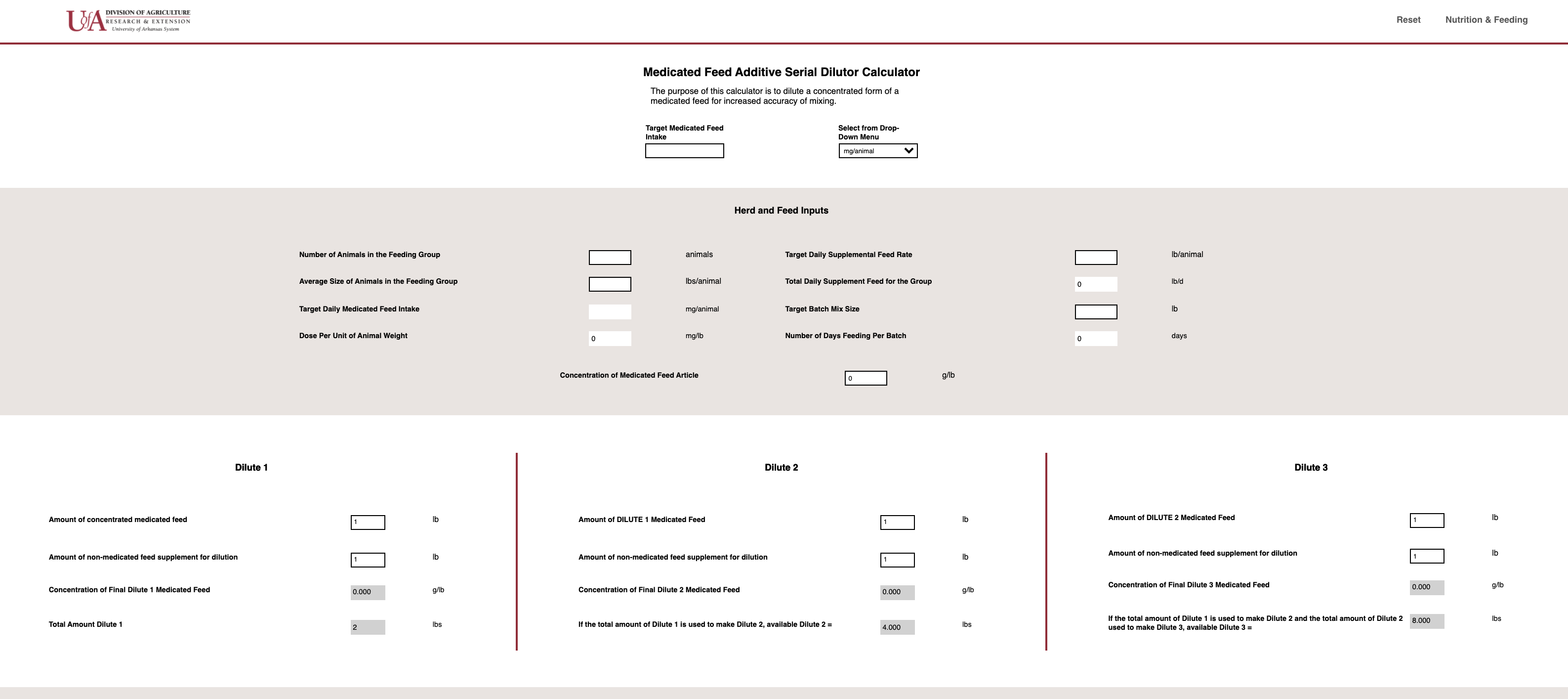Dec. 29, 2021
Feed additive calculator, favorite of ranchers and livestock producers, now available as online tool
By Ryan McGeeney
U of A System Division of Agriculture
Fast Facts:
- Calculator originally developed as spreadsheet to help veterinarians create safe & effective treatments for anaplasmosis
- Online calculator works across all platforms
(373 words)
LITTLE ROCK — The University of Arkansas System Division of Agriculture has adapted its popular Medicated Feed Additive Calculator for the 21st century. Ranchers and livestock producers can now access the calculator, available for the first time as a web-based tool, at https://medfeedcalc.uada.edu/.
A user guide for those new to the tool is available on the Division of Agriculture’s beef cattle nutrition and feeding page online at https://www.uaex.uada.edu/farm-ranch/animals-forages/beef-cattle/nutrition-feeding.aspx.
The tool was created to help veterinarians, industry professionals, feed blending facilities, and ranchers to calculate medicated feed additive inclusion rates while mixing feed.
Shane Gadberry, professor of ruminant nutrition for the Division of Agriculture, said he originally created the feed additive calculator in response to a recurring challenge for Arkansas beef producers.
“Several years ago, Arkansas was experiencing above-average incidences of anaplasmosis,” Gadberry said. “Producers were struggling with figuring how to get concentrated forms of chlortetracycline diluted down to more manageable blending rates.”
Anaplasmosis is a disease typically associated with bacteria transmitted through tick bites. Chlortetracycline is an antibiotic often used to treat the disease.
Gadberry created a spreadsheet that producers could use to calculate as many as three serial dilutions of a concentrated medicated feed to get the final concentration down to a more manageable inclusion rate for on-farm blending. With this tool, producers could more easily fabricate a safe, self-made premix in large batches.
“The serial dilution approach was also a means to help reduce mixing error,” Gadberry said.
When feed regulations were adopted in 2017 for medically important antimicrobials, more veterinarians began reaching out, seeking assistance in calculating medicated feed additive inclusion rates, Gadberry said.
Now the spreadsheet is available as an online calculator. Gadberry said that establishing the calculator as a website will help users avoid the need for specialized apps to access the tool.
“This also helps ensure it will function across different operating systems, so you can use it on your Apple device, Android device or a Windows-based PC,” he said.
Gadberry said there are no immediate plans to develop the calculator as a mobile app, but recommended that users add a shortcut to heir mobile web browser so that the tool will function similarly to a standalone app as long as the device is connected to the Internet.
To learn more about extension programs in Arkansas, contact your local Cooperative Extension Service agent or visit www.uaex.uada.edu. Follow us on Twitter at @UAEX_edu.
About the Division of Agriculture
The University of Arkansas System Division of Agriculture’s mission is to strengthen agriculture, communities, and families by connecting trusted research to the adoption of best practices. Through the Agricultural Experiment Station and the Cooperative Extension Service, the Division of Agriculture conducts research and extension work within the nation’s historic land grant education system.
The Division of Agriculture is one of 20 entities within the University of Arkansas System. It has offices in all 75 counties in Arkansas and faculty on five system campuses.
Pursuant to 7 CFR § 15.3, the University of Arkansas System Division of Agriculture offers all its Extension and Research programs and services (including employment) without regard to race, color, sex, national origin, religion, age, disability, marital or veteran status, genetic information, sexual preference, pregnancy or any other legally protected status, and is an equal opportunity institution.
# # #
Media contact:
Ryan McGeeney
Communications Services
University of Arkansas System Division of Agriculture
Cooperative Extension Service
(501) 671-2120
rmcgeeney@uada.edu
